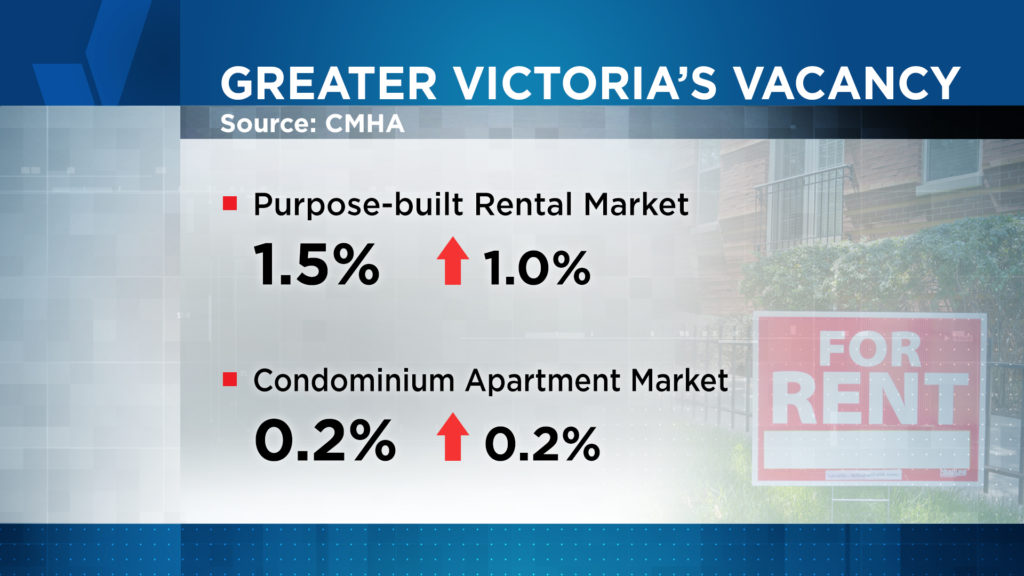A new report shows small improvements in the Greater Victoria rental market, but not enough to keep up with rental demand.
According to Canada Mortgage and Housing Corporation’s (CMHC) 2022 rental report, released Thursday, vacancy rates have made small increases in B.C.’s capital.
The vacancy rate for the purpose-built rental market, or apartment buildings, rose to 1.5 per cent, which is a one per cent increase from 2021. The condominium vacancy rate increased o.2 per cent.
That’s bucking a trend that saw a steep decline in the average national vacancy rate for purpose-built rentals from 3.1 per cent to 1.9 per cent.

Pershing Sun, senior analyst with CMHC, said while that’s one piece of positive news in a challenging market, it doesn’t make a dent in the demand.
“Victoria is still one of the tightest markets in Canada,” Sun said. “If you compare the 20 markets the report covers, you will find there’s only three or four markets that has a lower vacancy rate than Victoria.”
She said the vacancy rate continues to be driven by the demand for rentals, adding demand is going up as employment and immigration rates increase.
Another factor is the improving employment rate. According to the report, Victoria added 6,200 jobs added between January and October.
Since most of those jobs were for part-time workers who disproportionately rent instead of own, there was even greater rental demand.
That, combined with progressively higher immigration targets being set by the federal government until 2025, will continue to drive demand for the years to come and attract more people to the Capital Region, said Sun.
“It’s another evidence to reinforce the need for more supply,” she added.
Victoria’s rental market supply increased
CMHC reported a small increase in supply in 2022.
It said 1,411 units were added to the purpose-built rental apartment stock, and 229 units added to the condominium apartment stock. Both sectors grew by more than twice what they did in 2021.
“We actually have a record number of rental units coming online, but we know there is a lot more work to do,” Ravi Kahlon, Minister of Housing, told reporters Thursday.
Although apartment units are increasing, townhouse rentals have decreased.
The report states the Victoria area lost 83 of its purpose-built rental townhouses in 2022 — representing 12 per cent of its available stock.
Most of the losses were in Saanich and Central Saanich, which provides about half of the region’s rental townhouses.
That resulted in the vacancy rate of three-bedroom townhouses dropping from 6.2 per cent to 3.5 per cent in the area.
Rising rent puts Victoria behind only Vancouver, Toronto
Even with a general increase in unit supply, tenants may be disappointed to see that rents are still on the rise.
According to the CMHC, the majority of the new units are being priced at higher rent levels, which is contributing to a higher average rate.
The report said the average two-bedroom apartment unit in Victoria costs $1,699 per month for rent. That’s a 6.7 per cent jump from 2021.
In fact, Victoria has the third-highest rent in the country behind Vancouver at $2,002 and Toronto at $1,779.
Sun said one of the biggest cost factors is turnover in apartments, which is upping the price.
“We all know [in] turnover units, the rent is no longer subjected to the legislation of 1.5 per cent [rental] cap,” Sun explained.
She said an average two-bedroom turn over unit, or unit recently vacated, is now renting for 30 per cent higher than an occupied unit in the same building.
“These turn over units were a big contributor to overall rent increase,” Sun said.
The report added structures built after 2005, which are generally more expensive, had turnover rates twice as high as those for older apartments.
Affordable rentals still desperately needed
The report also highlighted a lack of affordable housing in the Greater Victoria area.
It said vacancy rates for units considered “affordable” to many households remains below one per cent.
Households earning less than $49,000 per year have an affordable vacancy rate of 0.4 per cent.
According to the report, three-bedroom units affordable to those earning less than $75,000 per year was 0.8 per cent.
It added only a third of the purpose-built rental units were affordable for households earning less than $49,000 per year.
“There’s some work to be done to replenish that type of housing,” Sun said.
She said the only real long-term solution for most of the Greater Victoria area’s problems is to add more supply, saying it’s something that is being done — just not fast enough to keep up to the demand.




